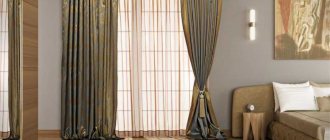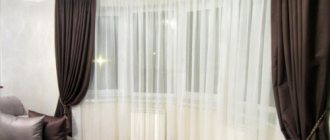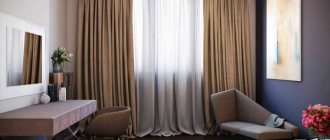Tulle in different rooms
The curtain can correspond to fashion for a long time, because it comes in different types:
- organza;
- muslin;
- veil;
- net;
- cobweb;
- with embroidery or pattern.
Various options are used in rooms, depending on the intensity of use of the curtains. For example, for the kitchen it is better to choose a mesh. This is a durable, moderately attractive fabric. It is resistant to mechanical stress, stains are easily washed off. For the kitchen, choose products that are plain or patterned.
For a child's room, a curtain is selected according to its properties, since in this case the only type is often considered - with a print, printed toys, favorite characters, etc. Pay attention to the strength of the fabric. Lace, printed tulle options, gossamer are less suitable varieties, but they are recommended for use in other rooms: bedroom, living room. In these rooms they also use a veil and organza.
Kisey will stand out from other types of tulle due to its narrow scope. This is a bright and unusual type of material, mainly used to divide space, and also in the living room.
Tulle filling
on the filling of the tulle and the correct calculation of the tulle , whether it will suit you completely, or not, and you will then supplement the tulle with something else, shorten it, lengthen it, etc.
To avoid mistakes, it is important to understand that when calculating tulle, filling is one of the main criteria for a good result in the end.
Small tulle filling
After studying many tutorials on sewing curtains, you will understand that the smallest recommended tulle filling is 1:1.5.
This means that, for example, for a standard 3-meter-wide window along the eaves in apartment buildings, a minimum of 4.5 meters of tulle will be required.
Less filling looks more than modest.
Calculate tulle
Designer tip:
There is another way in which calculate tulle with a filling ratio less than 1:1.5.
With a compositional solution of tulle and curtains , when there is no need to pick up these same curtains, you don’t have to “drive” the tulle behind the curtains, which means the filling of the tulle can be calculated for a different size of cornice, only going a little behind the curtains by 10-15 centimeters.
Medium fill tulle
The most common filling is 1:2. Here it becomes possible to fold the tulle, or gather the tulle into a small drapery with gathered braid.
Calculate tulle
Full tulle filling
The most beautiful and rich filling is 1:3. Those. for the same 3-meter window you will need 9 meters.
Everything here will be gorgeous, there are no words, even the fold, even the gathering will look very decent. I do not recommend using this filling for fabrics with large prints. In this case, the entire drawing will be lost.
Calculate tulle
What else can the calculation of tulle and its filling depend on?
One of the main principles of choice is the method of draping.
Ruffled tulle
This type of tulle is gathered with threads that are pulled from the curtain braid, giving a certain pattern when assembled.
The maximum fill factor is usually indicated on the packaging of the tape.
On average, the maximum ratio is 1: 2.5.
It is recommended to do this for a wide gathered braid, since with less filling, the intended pattern will simply not be visible when assembled.
The most common types of braid are uniform, gathered in vertical columns, puffs, or in common parlance “waffle”, gathered in an x-shaped pattern.
Calculate tulle
If these types of braid allow the filling factor of the braid to be reduced, and even increased by more than 2.5 times, then the braid that collects the tulle, for example, in a bow fold or a “glass” fold, requires a strict filling of the tulle of 1: 2.5 times.
Calculate tulle
Pleated tulle
When placing tulle into a fold manually, you need to know that a full fold involves triple filling of tulle.
You can read about the fold here.
If the tulle filling is not triple, then the fold will have to be laid at intervals. This fold looks good on tulle with vertical repeat pattern in stripes.
Calculate tulle
Another important parameter in calculating tulle is the density of the fabric and pattern.
Combination of curtains and drapes
This combination has been considered fashionable for a long time and is now also often used. This is a classic, and therefore timeless, window design option.
The combination of tulle (curtains) and curtains helps solve various problems:
- the intensity of room lighting is adjusted (high-density products are used in the evening, tulle in the morning);
- the style of the room is emphasized, for which it is important to choose the right type and color of curtains;
- an emphasis is placed on bright decorative elements, including curtains.
Recommendations to ensure the best results:
- the density of the material of tulle and curtains should be different: use transparent curtains (organza or veil), opaque curtains, the higher the density, the better, in this case the window design is based on the contrast of the properties of the products;
- it is necessary to choose the right pattern: it should not be on one of the curtains, but it is allowed to hang products on the window in the same style, only in this case the pattern should be in harmony, be the same for materials of different types;
- a contrast of shades is created: the tulle is light, because it covers the window even during the day, so it should be characterized by high light transmittance, and the curtains in most cases are much darker (for example, shades of brown), while the main selection criterion is the ability to retain light.
Criteria for choosing tulle width
When calculating the width of tulle fabric, you must be guided by certain criteria.
The size of the cornice, not the window
Some people mistakenly believe that knowing the width of the window, they can easily select the desired tulle size. This is not entirely true. It would be more correct to focus specifically on the width of the cornice, since its size is usually much longer than the window.
Room selection
Each room in the apartment serves specific purposes:
In the bedroom this is relaxation and relaxation; it is advisable to choose tulle for this room in darker colors and high density. It is better to take larger fabrics, both in width and in length, to create the necessary darkness and an atmosphere of comfort.
The kitchen offers a more active area. During the cooking process, grease and splashes from the stove may get in, so tulle curtains should not be too long and wide. But the colors of tulle in the kitchen are usually brighter or with a pattern.
The living room leaves plenty of room for creativity. You can choose tulle in any color, the main thing is that the window design is harmoniously combined with the overall style and emphasizes it favorably.
Taking into account the characteristics of the fabric
It is worth considering possible shrinkage of the fabric in the future (for example, when washing). Almost all types of tulle shrink, so you should add at least 5-10 cm to its width.
Types of drapery
It is also important to consider what type of decoration and drapery will be used. Tulle can lie in large waves or tails, or it can resemble a fluffy and airy skirt. To achieve the desired effect, you will need tulle of different widths.
Additional decoration
If the window design involves additional types of decor (lambrequins), then much more tulle will be needed than with conventional decoration.
Criteria for choosing tulle depending on the interior
The main parameters that influence the design of the room:
- type of fabric, weaving method and even production technology, which affects the external characteristics of the product;
- curtain color.
The presence of a pattern is also determined by the features of the interior.
Possible ways to design windows taking into account the design of the room:
- classic style: printed and plain material (veil, organza);
- Baroque: ruffles, multi-layered tulle curtain;
- country: the use of natural fabrics (cotton, linen) is suitable for decorating a window on the veranda of a country house;
- Provence: small flowers, curtains should be without design frills, as simplicity and floral motifs are important;
- minimalism: an important condition for window design is the absence of a large number of decorations on the curtains, the design on the fabric should be discreet and simple;
- to emphasize the loft style, choose products without ruffles, frills, lace, curtains must let light through, so they often use classic rectangular curtains in pastel colors, and more often choose products without a pattern;
- A summer terrace can be decorated with plain curtains made from the most airy fabric (organza).
Practical calculation examples
- The meter across the width of the canvas is the length of the cornice multiplied by the KS (assembly coefficient).
- The meter in height is the height from the cornice to the floor (another length) plus the margin for the hem (the bottom is separate, the top depends on the method of fastening), we add an adjustment to match the pattern.
- Fabrics with a large pattern, periodically repeated along the roll, are positioned so that it is entirely visible at the top or bottom of the curtain, depending on the design. When calculating, we sum up the length of the pattern repeat plus the additional cost for the full height.
- Sometimes the material puffs up when folds are formed, add another 3-5 cm for free sagging.
For tulle, the fold factor is 2 - 3 meters so that the curtain hangs beautifully on the window.
An example of calculations for a standard window, with a 2-meter cornice at a height of 2.6 m, if the fastening is on an assembly tape, tulle without a pattern:
- width: 2m x 2 (KS) = 4 m;
- length: 2.6 m + 0.15 m + 0.1 m = 2.85 m;
- patterned curtains with a repeat of 0.5 m, we count 2.6 m + 0.15 m + 0.1 m + 0.5 m = 3.35 m.
Attention ! To the resulting length we add a margin for hem (the top is larger, depends on the type of fastening, the bottom is enough 2 cm.)
With the help of correctly selected curtains, you can skillfully emphasize the design of the room.
To avoid any doubts when buying curtains with a large pattern, it is better to take about a meter in reserve. If a piece of fabric remains unclaimed, it is better to sew sofa cushions from it - an excellent interior decor. It is much worse to hang short curtains, lower the cornice, or come up with frills, wide contrasting stripes and other design elements, hiding the “undersize”.
How to hang tulle without a cornice beautifully
The main reason for choosing other methods of attaching curtains is the low strength of the wall. This option is considered if the entire surface of the supporting structure is protected by plasterboard. As a result, the opportunity to secure the cornice disappears. This is due to the significant load of this element.
The pressure on a weak facing material increases due to a curtain (curtains, drapes) hanging on the eaves.
Another reason for choosing an alternative method of mounting on a window is the purchase of a new item among fabrics, for which it is difficult to find a suitable cornice model. But it is important to immediately decide which option will be used: auxiliary means for fastening the fabric or a cornice, since in the first case it is often necessary to violate the integrity of the wall; installing a cornice in this place will then be problematic.
Possible methods of decorating a window using auxiliary means:
- Point mounting. At the same time, hooks and clips are installed. To fix them, a drill is used, which allows you to make holes in the wall where self-tapping screws with dowels will be inserted. The choice of fastening elements is carried out taking into account the characteristics of the fabric: the heavier it is, the more securely the hooks should be installed. Curtains are hung on them crosswise, folds are created, and tiebacks are used. If you drape a window in this way, you can divert attention from the fastening elements used.
- Textile adhesive tape. One side of it is fixed on the wall, the other is sewn to the curtain. This method is suitable for cases when you need to hang a single-layer tulle curtain. A bulky cornice is not considered due to the inconsistency with the appearance of the fabric.
- Metal rod on the wall. It remains invisible, because it will be covered with curtains. Magnets are used to secure the curtain itself. This option is suitable for cases where the curtain is light. For example, it is often chosen when you need to close a window on the landing of a private cottage. In this case, the magnets will be visible, which means it is better to choose a darker curtain.
- String or fishing line. The principle of fastening is the same as in the case of a metal rod. Only on a fishing line can you hang products using special hooks. The disadvantage of this method is the sagging of the fishing line. To avoid such consequences, you need to fix it along its entire length (the installation step of the fastening elements is reduced).
Determining length and width
If it is planned that an ordinary curtain will hang freely, then the width of the curtain can be equal to the length of the cornice. This is usually done when choosing the size of curtains for the kitchen on a cornice up to 1.4 m.
Author:
Zakharova Nina Afanasyevna
I hope you like my article! If you find any shortcomings, just write to me about it! I am always ready for a conversation and will answer any questions you have, ask them!











